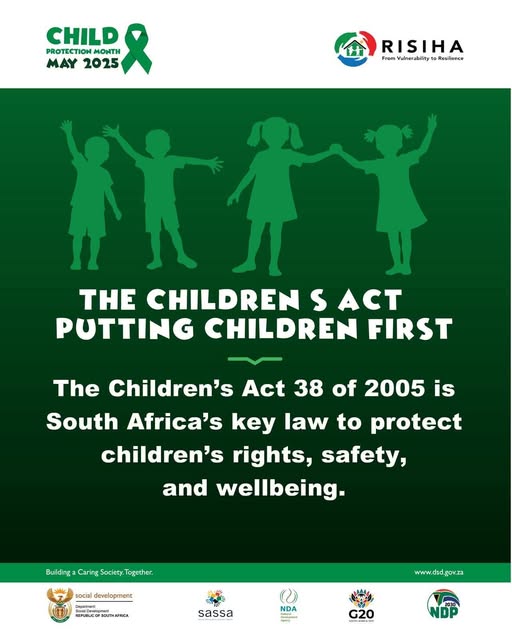As awareness campaigns like Child Protection Month conclude, experts and advocacy groups stress that the duty to safeguard children is a continuous, year-round responsibility.
The Legal Cornerstone: The Children's Act 38 of 2005
The Children’s Act 38 of 2005 serves as South Africa's primary legal instrument for child protection. It represents a significant shift from a welfare-based approach to a rights-based system, which places the child's needs and well-being at the absolute center of all legal and social matters concerning them.
Key Principles of the Act include:
-
The Best Interests of the Child: This is the guiding standard. All decisions made by courts, social services, or even within the family unit must prioritize the child's physical, emotional, and intellectual well-being as the primary consideration.
-
The Right to Participation: The Act acknowledges children as individuals with a voice. It grants them the right to participate and express their views in matters that affect them, with these views being given due weight in accordance with their age and level of maturity.
-
Parental Rights and Responsibilities: The legislation clearly defines the duties of parents and legal guardians, which include providing care, protection, and financial support for their children. It also establishes legal recourse for instances where these responsibilities are not fulfilled.
-
Protection from Harm: The Act offers explicit protection against all forms of maltreatment, neglect, abuse, and exploitation. It further imposes a legal obligation on specific professionals and a moral duty on all citizens to report any reasonable suspicion of harm against a child.
Expert Analysis: A Call for Proactive Prevention
According to Dr. Lerato Mokoena, a developmental psychologist and noted child protection advocate, a fundamental shift in mindset is required. "The societal focus must pivot from being solely reactive to proactively preventative," she states. "While reporting abuse is a non-negotiable duty, the real victory lies in creating environments where abuse is less likely to occur. This means fostering open communication in families, educating children about their rights and body autonomy, and building resilient communities where neighbours feel empowered to support one another."
Dr. Mokoena further explains that a child's sense of security is fundamental to their cognitive and emotional development. "A child who feels safe is a child who can learn, grow, and thrive. Constant exposure to threat or neglect, however, rewires their developing brain for survival, often with lifelong consequences."
From Awareness to Sustained Action: Recommended Practices
Child protection experts emphasize that safeguarding children is an active, ongoing process. They recommend several practical approaches for citizens and communities:
-
Promoting Education and Awareness: It is vital for the public to be educated on recognizing the signs of abuse and neglect, which are not always physical. Indicators can include sudden behavioural changes, unexplained fear of certain adults, social withdrawal, or persistent poor hygiene.
-
Understanding Legal and Moral Duties: While certain professionals like educators and healthcare workers have a mandated duty to report suspected abuse under the Act, a moral obligation rests on every citizen to act on reasonable suspicions to protect a child.
-
Encouraging Confident Reporting: The purpose of reporting is not to prove abuse but to raise a concern so that trained professionals can conduct a formal investigation. A report can be the critical intervention that saves a child from ongoing harm.
-
Creating and Maintaining Safe Environments: Communities, schools, and organizations are urged to implement and enforce policies that prioritize child safety. This includes thorough background checks for staff and volunteers and fostering a culture where children feel safe to speak up.
-
Supporting Vulnerable Families: Risk factors for neglect and abuse are often linked to socio-economic pressures like poverty and lack of social support. Community-led initiatives that assist struggling families can be a powerful preventative measure.
Authoritative Channels for Information and Assistance
For reliable information, guidance, or to report abuse, authoritative resources are available:
-
The Department of Social Development: As the primary government body for implementing the Children's Act, its website (www.dsd.gov.za) provides access to official documents and provincial contacts.
-
Childline South Africa: This non-profit organization operates a free, 24-hour helpline (116) for children and concerned adults, offering counselling and a direct channel for reporting abuse.
-
The South African Police Service (SAPS): In any situation of immediate danger or to report a criminal act against a child, the nearest police station or the national emergency number should be contacted.
In conclusion, the spirit of the Children’s Act calls for vigilant guardianship from all members of society. The expert consensus points toward a need to move beyond seasonal campaigns and embed child protection into the daily fabric of the community, ensuring every child’s fundamental right to a safe and nurturing childhood is upheld every day of the year.

